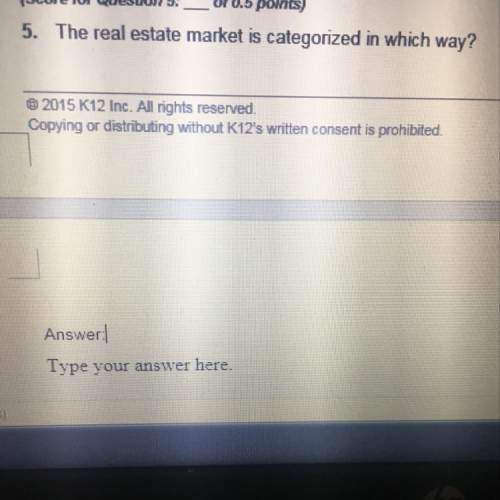
Business, 30.10.2019 01:31, nails4life324
On july 1, 2018, apache company, a real estate developer, sold a parcel of land to a construction company for $4,128,000. the book value of the land on apache’s books was $1,720,000. terms of the sale required a down payment of $172,000 and 23 annual payments of $172,000 plus interest at an appropriate interest rate due on each july 1 beginning in 2019. how much revenue will apache recognize for the sale (ignoring interest), assuming that it recognizes revenue at the point in time at which it transfers the land to the construction company? (leave no cells blank - be certain to enter "0" wherever required.)

Answers: 1
Other questions on the subject: Business

Business, 21.06.2019 19:30, qiuedhg
Consumer surplus is: the difference between the price of a product and what consumers were willing to pay for the product. the difference between the discounted price of a product and its retail price. the difference between the price paid by consumers and the price required of producers. the difference between the price of a product and consumers' valuation of the last unit of the product purchased.
Answers: 2

Business, 21.06.2019 20:30, jackiecroce1
Which of the following best describes the purpose of raising and lowering the required reserve ratio? a. to make sure that government spending does not result in either a surplus or deficit. b. to stimulate economic growth by making it less expensive for producers to get loans. c. to manage the economy by increasing or decreasing the amount of loans being made. d. to regulate the activity of private banks to assure an equitable distribution of wealth. 2b2t
Answers: 3

Business, 22.06.2019 01:30, whocaresfasdlaf9341
If a firm plans to issue new stock, flotation costs (investment bankers' fees) should not be ignored. there are two approaches to use to account for flotation costs. the first approach is to add the sum of flotation costs for the debt, preferred, and common stock and add them to the initial investment cost. because the investment cost is increased, the project's expected return is reduced so it may not meet the firm's hurdle rate for acceptance of the project. the second approach involves adjusting the cost of common equity as follows: . the difference between the flotation-adjusted cost of equity and the cost of equity calculated without the flotation adjustment represents the flotation cost adjustment. quantitative problem: barton industries expects next year's annual dividend, d1, to be $1.90 and it expects dividends to grow at a constant rate g = 4.3%. the firm's current common stock price, p0, is $22.00. if it needs to issue new common stock, the firm will encounter a 6% flotation cost, f. assume that the cost of equity calculated without the flotation adjustment is 12% and the cost of old common equity is 11.5%. what is the flotation cost adjustment that must be added to its cost of retaine
Answers: 1

Business, 22.06.2019 05:40, Jenan25
Grant, inc., acquired 30% of south co.’s voting stock for $200,000 on january 2, year 1, and did not elect the fair value option. the price equaled the carrying amount and the fair value of the interest purchased in south’s net assets. grant’s 30% interest in south gave grant the ability to exercise significant influence over south’s operating and financial policies. during year 1, south earned $80,000 and paid dividends of $50,000. south reported earnings of $100,000 for the 6 months ended june 30, year 2, and $200,000 for the year ended december 31, year 2. on july 1, year 2, grant sold half of its stock in south for $150,000 cash. south paid dividends of $60,000 on october 1, year 2. before income taxes, what amount should grant include in its year 1 income statement as a result of the investment?
Answers: 1
Do you know the correct answer?
On july 1, 2018, apache company, a real estate developer, sold a parcel of land to a construction co...
Questions in other subjects:


Chemistry, 20.11.2020 16:50





Computers and Technology, 20.11.2020 16:50










